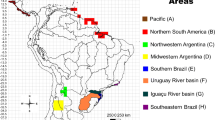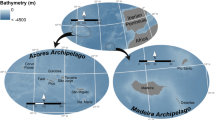Abstract
The comparative data from studies of two ‘superfamily’ groups with large numbers of subterranean taxa, the exclusively freshwater Crangonyctoidea and the predominately marine Hadzioidea, support the hypothesis that distributional patterns and evolutionary processes of stygobiont amphipods are closely linked and that the former can be a useful indicator of the latter. Three major biogeographic patterns are indicated by the distribution of subterranean species in these groups, each apparently reflecting a particular mode of origin: (1) freshwater stygobionts (limnostygobionts) derived from epigean freshwater ancestors through colonizations probably influenced by adaptive shifts, or assisted by stream capture and spring failure; (2) freshwater stygobionts derived from marine/brackish water ancestors by stranding during regression of marine embayments; and (3) marine/brackish water stygobionts (thalassostygobionts) derived from epigean marine/brackish water ancestors through adaptive shifts possibly in concert with fluctuating sea levels.
Zusammenfassung
Vergleichende Untersuchungen zweier Superfamilien, jede mit einer grossen Anzahl unterirdischer Taxa, die ausschiesslich im Süsswasser verbreiteten Crangonyctoidea und die vorwiegend marinen Hadzioidea, stützen die Hypothese, dass Verbreitungsmuster und phylogenetische Prozesse stygobionter Amphipoden eng miteinander verbunden sind, und dass Erstere ein nützlicher Indikator für Letztere sind. Die Verbreitung unterirdischer Arten in dieser Gruppe weist auf drei biogeographische Muster hin, von denen jedes eine bestimmte Herkunft reflecktiert: (1) Süsswasser-Stygobionten (Limnostygobionten) können durch Kolonisation, wahrscheinlich beeinflusst durch Veränderungen in der Anpassung, aus epigäischen Süsswasser-Vorfahren hergeleitet werden, oder unterstützt durch ‘stream capture’ and ‘spring failure’ (Versiegen von Quellen); (2) Süsswasser-Stygobionten stammen von marinen/Brackwasser-Vorfahren ab, welche im Verlauf der marinen Regression ‘gestrandet’ sind: und (3) marine/Brackwasser-Stygobionten (Thalassostygobionten) enstammen epigäischen marinen/Brackwasser-Vorfahren durch Veränderungen in der Anpassung in Zusammenhang mit Wasserstandsänderungen.
Similar content being viewed by others
References
Barnard, J. L. & C. M. Barnard, 1983. Freshwater Amphipoda of the World (Parts I & II): 1–830. Hayfield Associates, Mt. Vernon, (Va.), 830 pp.
Barr, T. C. & J. R. Holsinger, 1985. Speciation in cave faunas. Annu. Rev. Ecol. Syst. 16: 313–337.
Botosaneanu, L. & J. R. Holsinger, 1991. Some aspects concerning colonization of the subterranean realm — especially of subterranean waters: a response to Rouch & Danielopol, 1987. Stygologia 6: 11–39.
Bousfield, E. L., 1977. A new look at the systematics of gammaroidean amphipods of the world. Crustaceana Suppl. 4: 282–316.
Bousfield, E. L., 1982. Amphipoda. In S. S. Parker (ed.), Synopsis and Classification of Living Organisms. McGraw-Hill, New York: 254–239.
Boutin, C. & N. Coineau, 1988. Pseudoniphargus maroccanus n. sp. (subterranean amphipod), the first representative of the genus in Marocco. Phylogenetic relationships and paleobiogeography. Crustaceana Suppl. 13: 1–19.
Boutin, C. & M. Messouli, 1988a. Longipodacrangonyx maroccanus, n. gen., n. sp., nouveau représentant du group Metacrangonyx dans les eaux souterraines du Maroc. Crustaceana Suppl. 13: 256–271.
Boutin, C. & M. Messouli, 1988b. Metacrangonyx gineti n. sp. d'une source du Haut-Atlas marocain et la famille des Metacrangonyctidae n. fam. (Crustacés Amphipodes stygobies). Vie Milieu 38: 67–84.
Boutin, C. & N. Coineau, 1991. ‘Regression model’, ‘modèle biphase’ d'évolution et origine des micro-organisms stygobies interstitiels continentaux. Rev. Micropaléontol. 33: 303–322.
Culver, D. C., 1992. Cave life. Harvard Univ. Press, Cambridge, 189 pp.
Danielopol, D. L. & R. Rouch, 1991. L'adaptation des organismes au milieu aquatique souterrain. Réflexions sur l'apport des recherches écologiques récentes. Stygologia 6: 129–142.
Gould, S. J. & E. S. Vrba, 1982. Exaptation — a missing term in the science of form. Paleobiology 8: 4–15.
Holsinger, J. R., 1972. The freshwater amphipod crustaceans (Gammaridae) of North America. Biota of freshwater ecosystems, Identification Manual. U.S. Environmental Protection Agency 5: 1–89.
Holsinger, J. R., 1977. A review of the systematics of the Holarctic amphipod family Crangonyctidae. Crustaceana, Suppl. 4: 244–281.
Holsinger, J. R., 1978. Systematics of the subterranean amphipod Stygobromus (Crangonyctidae), Part II: species of the eastern United States. Smithson. Contr. Zool. 266: 1–144.
Holsinger, J. R., 1986a. Zoogeographic patterns of North American subterranean amphipod crustaceans. In R. H. Gore & K. L. Heck (eds), Crustacean Biogeography. Balkema, Rotterdam: 85–106.
Holsinger, J. R., 1986b. Amphipoda: Holarctic Crangonyctidae. In: L. Botosaneanu (ed.), Stygofauna Mundi. Brill, Leiden: 535–549.
Holsinger, J. R., 1988. Troglobites: the evolution of cave-dwelling organisms. Amer. Sci. 76: 146–153.
Holsinger, J. R., 1989. Allocrangonyctidae and Psudocrangonyctidae, two new families of Holarctic subterranean amphipod crustaceans (Gammaridea), with comments on their phylogenetic and zoogeographic relationships. Proc. biol. Soc. Wash. 102: 947–959.
Holsinger, J. R., 1991. What can vicariance biogeographic models tell us about the distributional history of subterranean amphipods? Hydrobiologia 223: 43–45.
Holsinger, J. R., 1992a. Two new species of the subterranean amphipod genus Bahadzia (Hadziidae) from the Yucatan Peninsula region of southern Mexico, with an analysis of phylogeny and biogeography of the genus. Stygologia 7: 85–106.
Holsinger, J. R., 1992b. Sternophysigidae, a new family of subterranean amphipods (Gammaridea: Crangonyctoidea) from South Africa, with description of Sternophysinx calceola, new species, and comments on phylogenetic and biogeographic relationships. J. Crust. Biol. 12: 111–124.
Holsinger, J. R. & G. Longley, 1980. The subterranean amphipod crustacean fauna of an artesian well in Texas. Smithson. Contr. Zool. 308: 1–62.
Holsinger, J. R., D. W. Williams, J. Yager & T. M. Iliffe, 1986. Zoogeographic implications of Bahadzia, a hadziid amphipod crustacean recently described from anchialine caves in the Bahamas and Turks and Caicos Islands. Stygologia 2: 77–83.
Holsinger, J. R. & D. C. Culver, 1988. The invertebrate cave fauna of Virginia and a part of eastern Tennesse: Zoogeography and ecology. Brimleyana 14: 1–162.
Howarth, F. G., 1987. The evolution of non-relictual tropical troglobites. Int. J. Speleol. 16: 1–16.
Karaman, G. S., 1969. XXI Beitrag zur Kenntnis der Amphipoden. Die Gattug Hadzia in Jugoslavien. Acta Mus. maced. Sci. nat. Skopje 11: 163–177.
Karaman, G. S., 1984. Contribution to the knowledge of the Amphipoda 133. New data on a genus Hadzia S. Kar. in Yugoslavia. Poljoprivreda i šumarstvo 30: 13–31.
Karaman, G. S., 1989. Hadzia fragilis stochi, n.ssp., from Italy (Amphipoda, Gammaridea, Hadziidae). Fragm. balc. Mus. maced. sci. nat. Skopje 14: 69–80.
Notenboom, J., 1988a. Phylogenetic relationships and biogeography of the groundwater-dwelling amphipod genus Pseudoniphargus (Crustacea), with emphasis on the Iberian species. Bijdr. Dierk. 58: 159–209.
Notenboom, J., 1988b. Biogeographical observations on the genera of Iberian stygobiont Amphipoda. Crustaceana Suppl. 13: 122–133.
Notenboom, J., 1988c. Parapseudoniphargus baetis, new genus, new species, a stygobiont amphipod crustacean from the Guadalquivir River basin (southern Spain), with phylogenetic implications. J. Crust. Biol. 8: 110–121.
Notenboom, J., 1991. Marine regressions and the evolution of groundwater dwelling amphipods (Crustacea). J. Biogeogr. 18: 437–454.
Rouch, R. & D. L. Danielopol, 1987. L'origine de la faune aquatique souterraine, entre le paradigme du refuge et le modèle de la colonisation active. Stygologia 3: 345–372.
Ruffo, S., 1979. Descrizione di due nuovi anfipodi anaftalmi dell'Iran e del Madagascar (Phreatomelita pacease n. gen. n. sp., Dussartiella madegassa n. gen. n. sp. Boll. Mus. civ. St. nat. Verona 6: 419–440.
Ruffo, S. & A. Vigna-Taglianti, 1987. Gammaropisa arganoi n. gen. n. sp. from the phreatic waters of southern Anatolia (Crustacea, Amphipoda, Gammaridae s. lato). Boll. Mus. civ. St. nat. Verona 14: 241–253.
Ruffo, S., 1986. Amphipoda: Groupe Metacrangonyx. In L. Botosaneanu (ed.), Stygofauna Mundi. E. J. Brill, Leiden: 550–552.
Skot, B., 1970. Über struktur und herkunft der unterirdischen fauna jugoslawiens. Biol. vestnik 18: 69–78.
Skot, B., 1986. Evaluation of some taxonomically, zoogeographically, or ecologically interesting finds in the hypogean waters of Yugoslavia (in the last decades). Commun. 9th Int. Cong. Espleol., Barcelona 2: 126–128.
Stock, J. H., 1977. The taxonomy and zoogeography of the hadziid Amphipoda, with emphasis on the West Indian Taxa. Stud. Fauna Curaçao 55: 1–130.
Stock, J. H., 1980. Regression model evolution as exemplified by the genus Pseudoniphargus (Amphipoda). Bijdr. Dierk. 50: 104–144.
Stock, J. H., 1981. The taxonomy and zoogeography of the family Bogidiellidae (Crustacea, Amphipoda), with emphasis on the West Indian taxa. Bijdr. Dierk. 52: 345–374.
Stock, J. H., 1985. Stygobiont amphipod crustaceans of the hadzioid group from Haiti. Bijdr. Dierk. 55: 331–426.
Stock, J. H., 1986. Amphipoda: Melitid grouping (Melitidae sensu Bousfield, 1973, emend.). In L. Botosaneanu (ed.), Stygofauna Mundi. E. J. Brill, Leiden: 504–518.
Stock, J. H., 1990. Insular groundwater biotas in the (sub)tropical Atlantic: a biogeographic synthesis. Atti Dei Convegni Lincei 85: 695–713.
Stock, J. H. & Y. W. Jo, 1990. Two Crangonyctidae (Crustacea, Amphipoda) from subterranean waters of the Far East. Stygologia 5: 119–127.
Stock, J. H. & D. Platvoet, 1991. The freshwater Amphipoda of the Falkland Islands. J. Nat. Hist. 25: 1469–1491.
Swofford, D. L., 1985. Phylogentic analysis using parsiomony. Version 2.4. User's manual. Illinois Nat. Hist. Surv., Champaign.
Vigna-Taglianti, A., 1987. A new cave amphipod of the hadziid group from Turkey. Boll. Mus. civ. St. nat. Verona 14: 439–452.
Wägele, J. W., 1990. Aspects of the evolution and biogeography of stygobiont Isopoda (Crustacea: Peracarida). Bijdr. Dierk. 60: 145–150.
Williams, W. D., 1986. Amphipoda on land masses derived from Gondwana. In L. Botosaneanu (ed.), Stygofauna Mundi. E. J. Brill, Leiden: 551–559.
Williams, W. D. & J. L. Barnard, 1988. The taxonomy of crangonyctoid Amphipoda (Crustacea) from Australian fresh waters: Foundation studies. Rec. Australian Mus., Suppl. 10: 1–180.
Author information
Authors and Affiliations
Rights and permissions
About this article
Cite this article
Holsinger, J.R. Pattern and process in the biogeography of subterranean amphipods. Hydrobiologia 287, 131–145 (1994). https://doi.org/10.1007/BF00006902
Issue Date:
DOI: https://doi.org/10.1007/BF00006902




